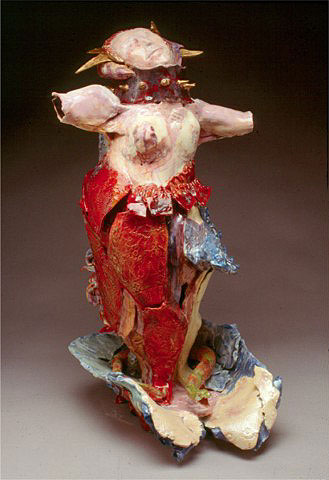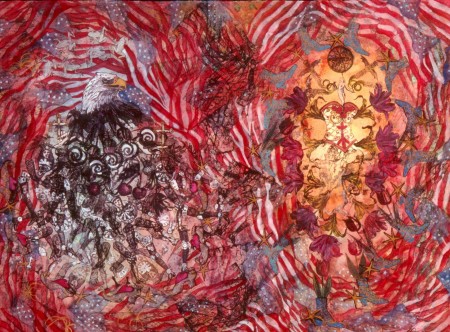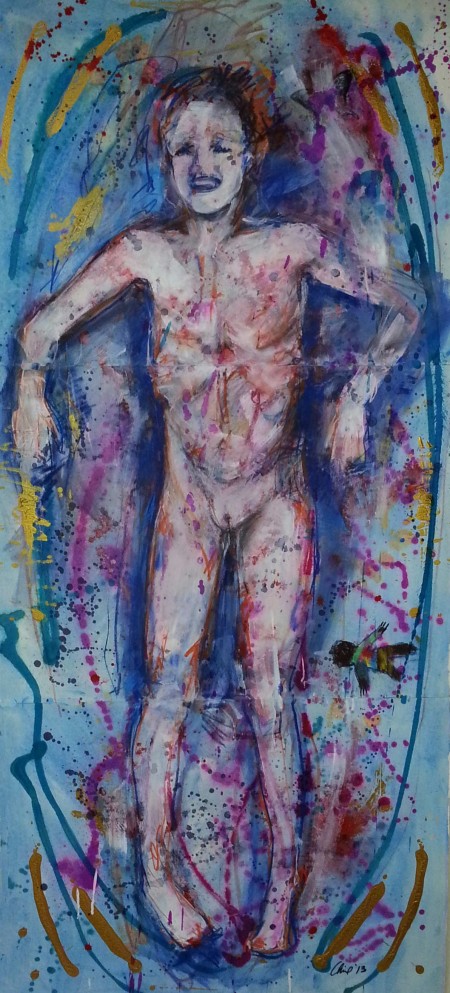I. Images For A Better World: Halena CLINE, Visual Artist
In 1988 Cincinnati-born visual artist Halena Cline visited a retrospective exhibition of Umberto Boccioni’s paintings at the Metropolitan Museum of Art in New York City. At the time she felt strongly the strength of his futuristic ideals and those of his comrades, ideals about moving beyond the past and establishing a strong future. She realized then that because of their expression in their art these artists were able to make a change and that society today could also benefit from artistic expression to shed its stale, reactionary and sometimes abusive attitudes. Isn’t art after all a window and a mirror?
Both a painter and a ceramic sculptor, Cline had felt all along and from the time she was very young, an urgent need to express herself in art. She has early childhood memories of painting with lipstick on mirrors. From age five to eleven she lived in an orphanage school, where she was led to believe she would have all the art materials she would want and need; unfortunately this proved not to be true. Subsequently, she lived in several foster homes, where she spent a good deal of her time alone, withdrawn, absorbed in making art.
At the age of 16 Cline dropped from high school and studied art for two years at what is now Antonelli’s College. A few years later, and after marriage and motherhood, she decided to pursue her art education and enrolled for two years at Northern Kentucky University studying printmaking, photography, drawing and painting.
Most of Cline’s work is evoked from her personal experiences and relationships, including imposed edicts from authorities beyond her control or because of the control she allowed due to her inexperience or ignorance. Femininity and womanhood, in particular, were frequent recurrent themes, Cline having experienced early on gender bias and feelings of being disposable. Her work always stressed the beauty of women, their important role in society, their quality and equality. Later themes focused more on the beauty and values of harmonious families and on the importance of a stable and secure environment for growing children. In addition, a large body of her work, prompted by the 2003 invasion of Iraq, deals with politics, with hegemony and control, and with the blind and unjustified violence and destruction they generate.
Cline has exhibited widely in solo, two-person, and invitational group shows locally, regionally and beyond – New York, Chicago, Atlanta, New Haven, Pittsburgh, New Orleans and as far west as Montana, and Seattle, WA. Her award winning works are found in many corporate and private collections.
Cline currently lives in Alexandria, KY, and holds a studio at the Pendleton Art Center, in Cincinnati, OH.
“Bearing the Dog,” a large mixed media painting which incorporates ceramics, was done to express Cline’s feelings of being undervalued as a woman. One of six daughters to a father who suffered from not having a son, Cline, fond of her father, reacted strongly and emotionally to his gender discrimination. Her piece represents her as a lifeless angel, symbolizing the negation of her identity as a woman, giving birth to a dog, a statement questioning the difference between a boy and a girl.
“A Live Dog Is Better off than a Dead Lion,” a ceramic sculpture, links womanhood to Cline’s personal family history, here her mother. Cline represents her as a martyr and a saint, her mother having had a difficult and tormented life, witnessing as a child the death of her own mother, having been raised by a physically abusive stepmother, experiencing a violent conjugal relationship. Cline depicts her, arms amputated outstretched as if crucified, a dog’s collar around her neck, a saint’s spikes on her head. She is stepping on a snake, reference to the feminine symbol of the Virgin Mary, and from her womb escapes a dove, allusion to the children she gave birth to and who flew on their own.
After having belonged for 26 years to the Jehovah Witnesses, Cline decided to leave the group and to literally cross the bridge, with the uncertainty, unknown and potential perils her new choices and new situation may present. She knew her courageous decision to be risky but she wanted nevertheless to move forward. Her painting “The Bridge” depicts this very personal and painful transition in her life.
Starting in the mid 2000’s, Cline did a series of large watercolors she called dual figures. Most are diptychs meant as interactive entities, similar to yin/yang, and most refer directly to American politics. They depict stamped images of political icons representative of war, might and hegemony presented next to counterparts carrying feminine traits and appearing unobtrusive. They show opposites, such as positive/negative, good/bad, masculine/feminine and include images of puppets, marionettes, American flag, American eagle, cowboy and military boots, money elements; they also include, and juxtaposed, feminine imagery implying reason, wisdom and a more humane approach to matters. The paintings “Merging Spheres” and “Three Hearts” are representative of the series.
Lately, Cline has been painting large watercolors including life-size outline drawings of people who are part of her life – her sister, daughters, grandchildren, dog, and friends. It is her way to express her vision of people she loves and cares for. “Chloe’s Playtime” is based on the outlines of her granddaughter’s Chloe and Rachel, her friend. They are both playing, worriless, surrounded by images of butterflies, slippers, hearts, and flowers… At the bottom, represented pictorially, is the progressive march of a baby. It is Cline’s nostalgic look at the peaceful and harmonious world of a little girl, the innocence of childhood that she did not know herself but would like to protect and maintain for her granddaughter and the children of the world.
One of Cline’s later child image paintings is “Lana in Bath”. It is a painting geared toward children’s vulnerability to which Society seems to be indifferent. Lana has brought with her to the tub her teddy bear, symbol of her innocence and naivety. She is naked, unaware of the evil that may be surrounding her. By representing her powerless, Cline is also referring to the many children murdered in school shootings like at Sandy Hook Elementary.
Cline’s painting “Women and Children First” shows a woman and a child falling and a man holding on so as not to fall. Cline meant to express through it the irony she finds in the phrase “Women and children first,” something maybe honorable on a sinking ship, but not in reality, since the world over, the value of women and children is often discounted, leaving them as abused victims for any conceived or political purpose. Sadly, in society, women and children are often the first ones to lose.
II. Words For A Better World: Bucky IGNATIUS, Literary Artist
Bucky Ignatius, a Cincinnati-born poet, has lived most of his 70 years, including all of the last 45, in his birth city. He has two daughters, both artists, and two grandsons, the real source of his optimism. For the past five years, he has served as president of the Greater Cincinnati Writers League (GCWL).
Like many members of the American anti-war movement that mushroomed in protest of the US involvement in Vietnam, Ignatius’ path to social consciousness was strongly influenced by the arts, predominantly music. In his teens, he harbored a secret passion for singing, and found a wealth of accessible material in the genre of folk music. The Kingston Trio was his gateway drug, and the progression through Chad Mitchell; Pete Seeger; Peter, Paul and Mary; Buffy Sainte-Marie and others, took him eventually to Bob Dylan, thanks to a folkie friend of his he had met in college.
In 1964, when Alabama’s segregationist Governor George Wallace, then a presidential candidate, came to Notre Dame’s campus for a speech, there was a small but significant protest demonstration, staged mostly by nuns; it deeply captivated Ignatius’ interest. What he found compelling at the time was far less connected to the justice or righteousness of the nuns’ positions than to the palpable passion they exuded. He found it impressive for someone to believe in anything that strongly!
At their father’s death in 1966, Ignatius’ oldest sister returned to the Midwest for the first time in several years. She had been teaching in the Bay Area in California while completing her PhD in French Literature at Stanford; she was filled with that same passion, focused on American foreign policy in general, and the escalation of the US involvement in Vietnam in particular. Ignatius then knew virtually nothing about Vietnam—the first combat troops having been sent there less than a year earlier. But he did know that his sister Mary Ann was very smart and not someone prone to wild flights of fancy. Mary Ann, who had lived in France and visited there several times, had developed since a deep understanding of the anti-colonialist nature of the rebellion that had defeated France, and viewed the American “domino theory” rationale with deep (and prescient) skepticism.
In 1967 Ignatius dropped out of college and found work as a bartender in Clifton. One night he heard of an all-night vigil at the Federal Building downtown where the Selective Service System (SSS), which oversaw the draft, had its regional induction center. He got off work at 3:00 am, and went downtown to check it out. There were about 100 protesters there, mostly students from Antioch College in Yellow Springs, near Dayton. Shortly before dawn, a young woman got the attention of building guards over what appeared to be a student suffering from a seizure. When the guards cracked the door to inquire, protesters forced it open, charged inside, and filled a hallway blocking entrance to the second-floor SSS offices. Ignatius could not, and did not resist the tide, and found himself in the Cincinnati Workhouse in the morning, one of a handful of Cincinnatians among nearly 100 people arrested. His process of “radicalization” had then begun.
A few months later, he was approached by a man named Jim Wessner who was planning on refusing induction into the army in Cincinnati as part of the Draft Resistance movement. Jim wanted to open a draft counseling office here, and was looking for someone local to help organize the office; his wife Hester, who had family money, would finance it. Ignatius agreed to help and got trained to serve as a counselor to young men facing the draft. The Cincinnati Draft Project, which was founded early in 1968 with an office on 7th Street downtown, grew quickly and had several counselors trained and a busy office up and running. Ignatius decided then to move to a bigger pond, so to speak, and joined his girlfriend in New York City where she was resuming her college studies at Columbia. There, the local SDS chapter was making national headlines in a protest that brought the University to a standstill, with six campus buildings occupied for more than a week. Upon his arrival, Ignatius landed a proofreading job, joined the SDS chapter, and spent the next year becoming ever more deeply convinced of the need for resistance to America’s move away from its altruistic ideals toward a global domination politics based on the belief that “might makes right.” At the same time, he had seen exactly the same human delusions and power-seeking addictions infiltrate every idealistic organization he had been part of, i.e. Church, State, SDS, the Yippies…
Late in 1969, and at the wise old age of 25, Ignatius decided to move back to Cincinnati to take stock. There he joined a hippie commune, and with what grew to be a few dozen collaborators, lived in Clermont County in a cooperative community, where they made a scant living making and selling candles, trying at the same time to learn the basics of economic systems, governance, playing well with others… These topics have continued to interest him, and are reflected in the poems below, which here appear in chronological order.
1) In “Beatitude Adjustment,” written 20 years ago, Ignatius vented his simmering rage at the hypocrisy of political rhetoric appearing in his daily paper. Even though he thinks that this kind of light-shining is important, and that his poem does it pretty well, Ignatius rarely writes poems from this place anymore, for mostly selfish reasons: he does not like mixing such toxicity with poetry, because he doesn’t like how it feels to be that open to it, which is required for him to receive a poem. In any case, he suspects that such a rhetoric might either make people nod, or mad, and not sure how much consciousness change could really happen as a result.
Beatitude Adjustment
Woe to those who rush to render
what is worldly, due to Caesar,
to themselves in Jesus’ name.
With Jesus’ name a useful tool, a lure,
a crutch, smokescreen, crowbar,
whatever’s needed for the goal—
Caesar illusion of control and lust
for power—this base profanity lies
safe inside the fortress of denial.
Woe to those who public pose
as Christian, while in heart and speech
discard the poor, scorn the meek,
spend righteousness on victory,
trade pure-in-heart for legal;
beatitude adjustments to enhance
the poll position of those blessed
with ambition and good circumstance.
If you must play the power game,
please, not in sweet Jesus’ name.
2) “Carousel” was in response to Ignatius’ older daughter Ryonen’s observation that she liked his poems that had ‘edge’ best. From that came the first phrase of the poem, and the rest, for Ignatius, a simple matter of navel gazing and probably twenty or thirty hours of revisions and tweaks.
Carousel
Time has worn my edges
smooth, revolutionary zeal
gone from flower to seed,
and now, it’s thank-you notes,
love letters too, and one-breath
meditations—small-change
contributions to the turning
of the world.
Good players know the game
by heart—a schoolyard carousel
where running children push,
jump on, leap off, to reel in
dizzy glee, trying not to puke
or fall too hard or scrape
a knee—a playful revolution,
and thrill enough for me.
3) The title of the poem “Sermonette” comes from a Lambert, Hendricks and Ross tune. For Ignatius the poem is pretty much a blinding flash of the obvious; but also a reminder that we still drill and guzzle and that the highest hill in all of Butler County is Mt. Rumpke.
Sermonette
Oh foolish man,
try to conquer
nature for your
comfort and she
will brush you
aside like a
bad idea.
4) Neil Armstrong stepped onto the moon on Ignatius’ twenty-fifth birthday; Ignatius felt sure then that we would see soon our global interconnectedness. But he was only 25 and possibly naive… The poem “Adrift” blew in him during one of the many weeks of Siberia that visited us last winter.
Adrift
Strange how deep snow
makes us aware
we’re all in this
together, when
deep space
doesn’t.
5) Ignatius’ meditation and worship mostly take place in his garden. And though there’s something profane about a haiku rant, Ignatius is slightly proud of this one. Even if it drowns out zen silence with the smoke and roar and smell of complaining, it does go 5-7-5 with a nice season reference, has a third line twist with at least an Oh hell! moment.
haiku
nothing speaks louder
to American decline
than a leaf blower
6) When he joined a church in the 1990s, Ignatius was assigned to write a “Faith Statement.” Part of that project was a list poem, litany-like, listing some important things he believed. First and foremost was: ‘Everything I believe might be wrong. On all the great questions where there is no global consensus—religion, political or economic ideology, anyone who is sure he is right is fatally flawed with arrogance and not to be trusted.’ That’s Ignatius’ view, and he is sticking to it. As time goes on he also finds himself to be less ambitious and less convinced and concurs with John Lennon’s saying: “The more I see, the less I know for sure.”
Credo
One mantra
can save
the world:
All that I
believe might
be wrong.
–Saad Ghosn











